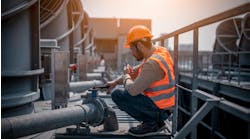Steam finds wide use in chemical processing for applications ranging from heating fluids to driving equipment. The boilers that generate this steam from water come in many different varieties and sizes. So, here, we’ll look at the types and designs of boilers for process plants, as well as issues related to their safety, reliability and efficient operation. We’ll also discuss accessories and condition monitoring.
First, let’s go over some basics. Only purified water should serve as boiler feed water (BFW). The water may flow through, e.g., horizontal, vertical or spiral-wound tubes. The tubes may be smooth, ribbed, etc. Boilers rely on a combination of radiant and convective heat transfer; they consist of a furnace (hot gas) section and steam-containing parts (tubes, etc.). A lower mean temperature difference between the hot gas and the steam usually mandates an increase in the surface of tubing and boiler weight. High temperature boilers require special alloys such as nickel-based ones for their hot section.
Designers strive to optimize heat transfer and, thus, efficiency. Higher efficiency reduces the fuel input and the combustion product mass rates, which also means less pollution and emissions. It also translates into a smaller size boiler.
Variants
Boilers come in many different types and designs. A commonly used configuration uses a steam drum. In this type, the water enters the boiler through a section in the convection pass called the economizer. From the economizer, it passes to the steam drum. Once there, the water travels via downcomers to the lower inlet water-wall headers. From these headers, the water rises through the water walls and eventually changes into steam due to the heat generated, for instance, by burners. This steam enters the steam drum. It moves through a series of steam and water separators and then dryers inside the steam drum. These remove water droplets from the steam and then the cycle through the water walls is repeated. Forcing the water to the boiler usually requires a special set of feedwater pumps.
Many large boilers have a steam drum and use water tubes embedded in the walls of the furnace combustion zone; these units come in different layouts and arrangements to allow picking a configuration offering the best efficiency for a specific application. The saturated steam from the steam drum flows through tubes heated by the hot combustion gases, becoming superheated. The hot gases also preheat the steam entering the steam drum and the combustion air going into the combustion zone.
Another variant is a simpler design known as a once-through boiler. This system has no steam drum. The water goes through the economizer, the furnace wall tubes and the superheater section in one continuous pass; there’s no recirculation. Here too, a set of feedwater pumps supplies the motive force for the flow through the boiler.
Dried steam is essential for many applications. For instance, any droplets of liquid water carried over into a steam turbine can produce destructive erosion of the turbine blades. Therefore, the boiler system must generate dried superheated steam.
Supercritical Once-Through Boilers
At the critical point of a fluid, distinct liquid and gas phases don’t exist and there’s no phase boundary between liquid and gas. As the critical point is neared, the properties of the gas and liquid phases approach one another. At the critical point, only one phase exists, a homogeneous supercritical fluid. Some engineers call systems using this approach steam generators, not boilers, because they don’t actually boil water. However, the term boilers is widely used for them and, so, we’ll refer to them as boilers in this article.
For large supercritical steam boilers, the once-through configuration is the preferred option boilers as there’s no need for a steam drum or similar provisions because separate liquid and gas phases don’t exist.
A supercritical steam generator operates at pressures above the critical pressure, say, around 220 Barg. Liquid water immediately becomes steam. The efficiency of the overall operation exceeds that of a subcritical steam system.
Other factors also favor supercritical once-through boilers. For instance, by obviating steam drums, these systems avoid the problems and potential incidents (including catastrophic explosions) often posed by steam drums.
Such systems typically involve water entering the boiler at a pressure above the critical pressure, getting heated to a temperature above the critical temperature (say, to 375°C) and then being expanded to dry steam at some lower subcritical pressure. This can occur via different configurations, for instance, a throttle valve located downstream of the evaporator section of the boiler.
Many supercritical once-through boilers used in plants have pressures in the range of 250–350 Barg and temperatures of 500–650°C, well above the critical point of water. However, opting for more moderate conditions, say, just above 240 Barg and 500°C, reduces operational complexity and improves reliability. The high-pressure steam generated can undergo step-by-step reduction to provide medium- and low-pressure steam if needed.
The primary disadvantage of supercritical steam boilers is their need for extremely pure BFW, say, on the order of about 0.1 ppm by weight of total dissolved solids (TDS). Another challenge is operation at part load. At full load, the mass of fluid in the tubes avoids excessively high temperatures. However, at part load, the lower volumes of delivered water and generated steam raise the chance of overheating.
So, an important consideration is how the boiler would operate at partial water flow. A traditional method of part-load operation uses sliding pressure control, with progressive reduction in operating pressure, to minimize temperature variation of the generated steam. When the pressure in the furnace-wall tubes drops below the critical pressure, the mass required to avoid overheating increases dramatically. For this reason, a number of boilers operate with the furnace walls at full pressure and superheaters operating under sliding pressure. This arrangement relies on a number of throttling duty valves, which can affect plant reliability, availability and maintenance requirements.
Some boilers instead use a spiral-wound furnace, with inclined tubes as opposed to vertical tubes. Such an arrangement reduces the number of tubes in the furnace and, hence, raises the fluid mass in each tube. At the same time, it increases the individual tube length; each tube passes through every part of the furnace heat transfer surface. This smooths out variations in heat input between, for example, mid-wall and corner locations because each tube passes through both regions.
Many different options exist for dealing with part-load operation, with the proper choice depending upon the specific boiler application.
Safety, Reliability And Operation
Each year, numerous boiler accidents and failures occur. Most stem from malfunction of different parts, error in operation, poor maintenance, corrosion, etc. Properly functioning control and safety devices are absolutely essential. In addition, you must establish and enforce regular testing and verification regimes to provide confidence the safety and control features will work when needed.
Safety or relief valves usually serve as the primary safety feature on a boiler; these valves prevent dangerous over-pressurization. Safety valves are required in case there’s failure of pressure controls or other devices designed to control the firing rate. If something goes wrong, the safety valve is designed to relieve all the pressure generated within the boiler. So, you should think of the safety valve as the last line of defence. It should have sufficient relieving capacity to meet or exceed the maximum burner output. Several factors, such as internal corrosion, restricted flow, etc., can impede the ability of a safety valve system to function as desired. Internal corrosion is probably the most common cause of freezing or binding of safety valves. Keep all safety valves free of debris or foreign materials and test their operation regularly. It’s not good practice to operate a boiler too close to the safety valve setting. This may cause the valve to leak slightly, resulting in an internal corrosion build-up that eventually will prevent the valve from operating. As a very rough indication, a boiler’s steam pressure often is maintained at approximately 75–80% of the safety-valve set pressure.
Water flow or level control and low-water fuel cut-off usually serve as the other important control and safety features of a boiler. These devices perform two separate functions. However, on very simple and small boilers, they often are combined into a single unit that provides both a water control function and the safety feature of a low-water fuel cut-off device. However, for many boilers, two separate sets of devices should handle these two functions. Usually, a boiler, particularly a medium or large one, should have two independent low-water fuel cut-off devices (a primary and a secondary). Many codes and jurisdictions require two such independent devices on steam boilers.
Modern fuel systems for boilers are complex assemblies, consisting of both electronic and mechanical components. Many things can go wrong with a boiler’s fuel system. For instance, ignition transformers may deteriorate or fail; ignition electrodes may burn and become coated; fuel strainers and burner equipment may clog up; fuel valves may get dirty and leak; air/fuel ratios may drift out of adjustment; and flame scanners may become dirty. A fuel system should incorporate many safety features. The burner system, in particular, requires periodic cleaning and routine maintenance. Failure to maintain the equipment in good working order could result in many problems such as excessive fuel consumption, loss of heat transfer or even an explosion.
The flow of water in different parts of the boiler as well as the temperature profile in the furnace and hot gas sections demand care; these are key operational parameters that require measurement. For example, stack temperature reflects the temperature of the flue gas leaving the boiler. A higher-than-usual stack temperature indicates the tubes may be getting a build-up of soot or scale and inefficiencies exist in the heat transfer regime.
The majority of boiler troubles, failures and accidents are avoidable. One of the most effective tools to prevent such problems is condition monitoring. Most boiler problems and issues don’t occur suddenly but develop slowly over a long period of time. The best way to detect important changes that may otherwise go unnoticed is to comprehensively record condition data and carefully evaluate those data periodically.
For the best performance, safety and reliability, maintain the fire in the furnace section as uniformly as possible to avoid an excessive rate of combustion, undesirable variations in temperature, and possible explosions. The destructive force in a boiler explosion comes from the instant release of energy whether in combustion system or steam sections.
AMIN ALMASI is a mechanical consultant based in Sydney, Australia. Email him at [email protected].

